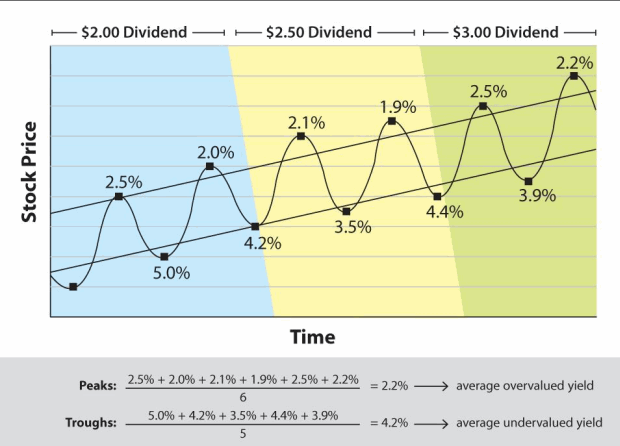The Most Profitable Dividend Investing Strategy: Simplicity Wins

Table of Contents
Understanding the Fundamentals of Dividend Investing
Before diving into strategy, it's crucial to understand the basics.
What are Dividends?
Dividends are payments made by a company to its shareholders, typically from its profits. These payments represent a share of the company's earnings, rewarding investors for their ownership. They are a key component of a successful long-term investment plan.
- Regular Dividends: Paid out consistently, usually quarterly, reflecting a company's ongoing profitability.
- Special Dividends: One-time payments, often reflecting a significant event like a large asset sale or unexpected profits.
- Dividend Payout Ratio: The percentage of earnings a company pays out as dividends. A sustainable payout ratio (generally below 70%) signals financial health. This is a key metric when evaluating dividend yield and dividend growth potential. Understanding this ratio is crucial to finding good dividend-paying stocks.
Understanding terms like dividend yield (the annual dividend payment relative to the stock price) and utilizing a dividend reinvestment plan (DRIP), where dividends are automatically reinvested to purchase more shares, are also essential aspects of dividend investing.
Identifying High-Quality Dividend Stocks
Choosing the right stocks is vital. Focus on companies with:
- Financial Stability: Analyze balance sheets, cash flow statements, and debt levels to ensure consistent profitability.
- Consistent Dividend History: Look for companies with a long history of paying dividends, indicating a commitment to shareholder returns. Dividend Aristocrats and Dividend Kings, companies with long streaks of increasing dividends, are often excellent choices.
- Sustainable Payout Ratio: Avoid companies paying out a disproportionate share of their earnings as dividends.
- Strong Industry Position: Invest in companies with strong market share, competitive advantages, and growth potential within their respective industries. Identifying strong blue-chip stocks often helps with this. Use fundamental analysis to thoroughly assess these factors.
The Power of Simplicity: A Step-by-Step Approach
A simple, disciplined approach maximizes returns and minimizes risk.
Diversification for Risk Management
Spread your investments across various dividend-paying stocks to mitigate risk. This is portfolio diversification.
- Sector Diversification: Invest across different sectors (technology, healthcare, consumer goods, etc.) to reduce the impact of industry-specific downturns.
- Market Cap Diversification: Include companies with varying market capitalizations (small, mid, large-cap) to balance risk and potential returns. This forms part of a solid asset allocation strategy.
Dollar-Cost Averaging (DCA) for Consistent Growth
Dollar-cost averaging involves investing a fixed amount of money at regular intervals, regardless of market fluctuations.
- Reduces the risk of buying high and selling low by averaging your purchase price over time. This is a strong counter to attempting to time the market.
- Removes the emotional aspect of trying to pick the perfect entry point.
- Leads to consistent growth over the long term. This is a core part of a robust long-term investment strategy.
Reinvesting Profits: The Importance of Dividend Reinvestment
Reinvesting your dividends is crucial for maximizing long-term growth.
- Leverages the power of compound interest: Earn interest on your initial investment and on accumulated dividends.
- Dividend reinvestment plans (DRIPs) automate this process, buying additional shares with each dividend payment.
- Accelerates long-term wealth building significantly.
Avoiding Common Pitfalls in Dividend Investing
Even a simple strategy requires awareness of potential pitfalls.
The Dangers of Chasing High Yields
High-yield stocks might seem attractive, but they can be dividend traps.
- Often signify underlying financial instability, potentially leading to dividend cuts or even bankruptcy.
- Prioritize financial health and sustainability over yield alone. Successful value investing relies on this principle.
Emotional Investing and Market Timing
Avoid impulsive decisions based on market fluctuations.
- Emotional responses often lead to poor investment choices.
- Stick to your disciplined strategy, regardless of short-term market volatility. Patience in investing is key to success. A long-term investment strategy is crucial to mitigate short-term market volatility.
Conclusion: Simplicity Triumphs in Profitable Dividend Investing
The most profitable dividend investing strategy isn't about complexity; it's about discipline. Diversification, dollar-cost averaging, and dividend reinvestment form a powerful combination. By focusing on these simple principles and avoiding common pitfalls, you can build a robust and profitable dividend income stream. Discover the most profitable dividend investing strategy and implement a simple, profitable dividend investing strategy now. Start building your own portfolio today!

Featured Posts
-
 The Untold Story Of Prince Andrews Explosive Behavior Palace Staff Testimony
May 11, 2025
The Untold Story Of Prince Andrews Explosive Behavior Palace Staff Testimony
May 11, 2025 -
 Controversy Pvv Minister Rejects Royal Honors For Asylum Volunteers
May 11, 2025
Controversy Pvv Minister Rejects Royal Honors For Asylum Volunteers
May 11, 2025 -
 Ipswich Town Kieran Stevenson Focused On The Future
May 11, 2025
Ipswich Town Kieran Stevenson Focused On The Future
May 11, 2025 -
 Stellantis Nears Ceo Decision Top Contender Emerges From U S Operations
May 11, 2025
Stellantis Nears Ceo Decision Top Contender Emerges From U S Operations
May 11, 2025 -
 Jay Kelly I Nea Tainia Me Toys Kloynei Kai Santler
May 11, 2025
Jay Kelly I Nea Tainia Me Toys Kloynei Kai Santler
May 11, 2025
